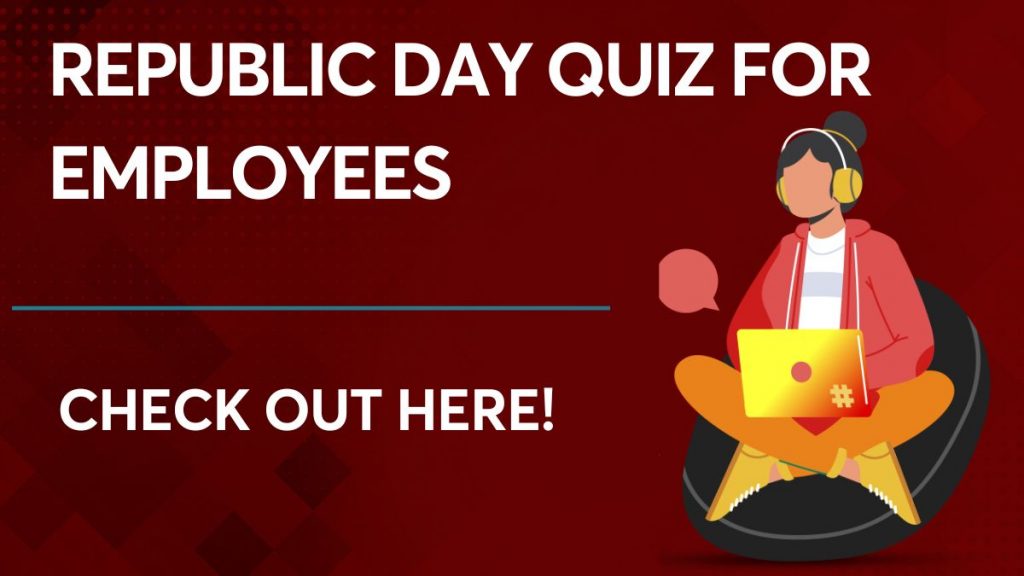Republic Day Quiz for employees: One of our nation’s three official holidays, Republic Day is observed on January 26 each year to honor the Indian Constitution, which came into effect on that day in 1950. The Indian Constitution is renowned for its enormous size and is the longest constitution in the world. Try out this specially crafted Republic Day quiz, which highlights the efforts made by the Constitution’s authors and introduces you to many aspects of India becoming a Republic. Additionally, it contains details on Republic Day in 2023, which can be used to answer queries in the current affairs section that may be linked to this subject.
Republic Day Quiz for Employees
Republic Day has always been significant for candidates preparing for competitive entrance examinations. Here are some interesting Republic Day questions in the style of a Republic Day Quiz for employees. In conclusion, investigate the answers to these questions.
Q1. When is India’s Republic Day observed?
- January 26th
- August 15th
- October 2nd
- March 23rd
Answer- January 26th
Q2. Why is Republic Day celebrated in India?
- Commemorates the independence of India
- Commemorates the adoption of the Indian Constitution
- Commemorates the coronation of the first Indian king
- Commemorates the victory in a war
Answer- Commemorates the adoption of the Indian Constitution
Q3. Where is India’s primary Republic Day parade held?
- New Delhi
- Mumbai
- Kolkata
- Chennai
Answer- New Delhi
Check the latest updates below-
Q4. When was the Indian Constitution enacted?
- 1950
- 1949
- 1947
- 1948
Answer- 1949
Q5. Who designed the National Flag of India?
- Mahatma Gandhi
- Jawaharlal Nehru
- Sardar Patel
- Pingali Venkayya
Answer- Pingali Venkayya
Q6. On Republic Day in New Delhi, who salutes during the great parade?
- President
- Prime Minister
- Governor
- Defence Minister
Answer- President
Q7. Who unfurls the National Flag at the state capitals’ Republic Day ceremonies?
- Chief Minister
- Governor
- Deputy Chief Minister
- Finance Minister
Answer- Governor
Q8. On Republic Day, who was the first Indian woman to wave the Indian national flag?
- Sarla Thakral
- Kiran Bedi
- Indira Gandhi
- Kiran Mazumdar-Shaw
Answer- Sarla Thakral
Q9. What features prominently in the Republic Day parade?
- Military parade
- Cultural parade
- Sports parade
- Religious parade
Answer- Cultural parade
Q10. How many times did the country’s anthem play before the Republic Day parade?
- Once
- Twice
- Three times
- Four times
Answer- Twice
Q11. Who is the chief guest at the Republic Day parade in India?
- President of India
- Prime Minister of India
- Head of State or Government of a foreign country
- Chief Justice of India
Answer- Head of State or Government of a foreign country
Q12. Who participated in the Republic Day parade as the highest-ranking military officer?
- Chief of Army Staff
- Chief of Air Staff
- Chief of Naval Staff
- Chief of Defence Staff
Answer- Chief of Defence Staff
FAQs on Republic Day Quiz for Employees
Republic Day is celebrated to mark the adoption of the Indian Constitution, which came into effect on January 26, 1950. It marks the day when India became a republic and the Constitution of India came into force.
Republic Day is celebrated with a grand parade in the capital city of New Delhi, where floats representing different states and cultural groups are displayed. The President of India also gives a speech and there is a display of military might and cultural performances. People also hoist the national flag and sing the national anthem.
January 26th is significant for India as it marks the day when the Constitution of India came into force, making India a republic. The Constitution of India came into effect on January 26, 1950, and replaced the Government of India Act of 1935.
The parade on Republic Day is a display of India’s cultural and military heritage. The parade features floats representing different states and cultural groups and also includes a display of military might with a march past by the armed forces. The parade also includes a display of folk dances and cultural performances.
